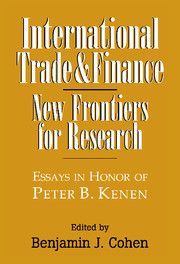Book contents
- Frontmatter
- Contents
- List of contributors
- Introduction
- 1 The practical theorist: Peter Kenen's contribution to international economics
- I International trade theory
- II International monetary theory
- 5 Exchange rate regimes and international trade
- 6 Exchange rates and investment response in Latin America
- 7 Optimum currency areas and exchange rate volatility: Theory and evidence compared
- 8 Optimum currency area theory: Bringing the market back in
- III Applied policy analysis
- Index
7 - Optimum currency areas and exchange rate volatility: Theory and evidence compared
Published online by Cambridge University Press: 11 September 2009
- Frontmatter
- Contents
- List of contributors
- Introduction
- 1 The practical theorist: Peter Kenen's contribution to international economics
- I International trade theory
- II International monetary theory
- 5 Exchange rate regimes and international trade
- 6 Exchange rates and investment response in Latin America
- 7 Optimum currency areas and exchange rate volatility: Theory and evidence compared
- 8 Optimum currency area theory: Bringing the market back in
- III Applied policy analysis
- Index
Summary
Introduction
One of the limitations of the literature on optimum currency areas, a topic to which Peter Kenen so importantly contributed, has always been the difficulty of confronting theory with evidence. We have at best limited information on the symmetry of shocks, the sectoral distribution of employment, the mobility of labor, the volume of interregional trade, and the other variables assumed to drive the decision of whether to form a monetary union (Mundell 1961; McKinnon 1963; Kenen 1969). Precisely because they are monetary unions, few national states gather data with which to test the predictions of optimum currency area (OCA) theory. It is not hard to see why: one can imagine the political problems that would arise were it discovered, for example, that New York runs a trade deficit with the rest of the United States.
If the theory of optimum currency areas does in fact possess significant explanatory power, then the same factors that influence monetary arrangements within countries should also govern arrangements between them. In the same way that two regions should form a monetary union if they experience similar disturbances, factors of production flow freely between them, and they trade heavily with one another, we should expect to see two countries that maintain separate currencies follow different exchange-rate-management practices depending on whether these conditions are or are not met.
- Type
- Chapter
- Information
- International Trade and FinanceNew Frontiers for Research, pp. 184 - 215Publisher: Cambridge University PressPrint publication year: 1997
- 12
- Cited by

